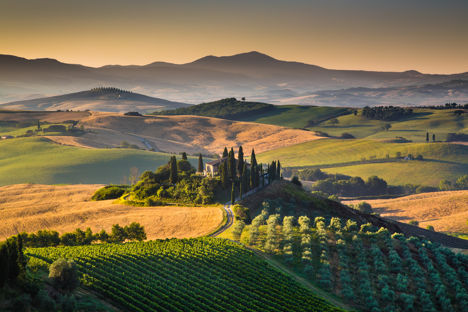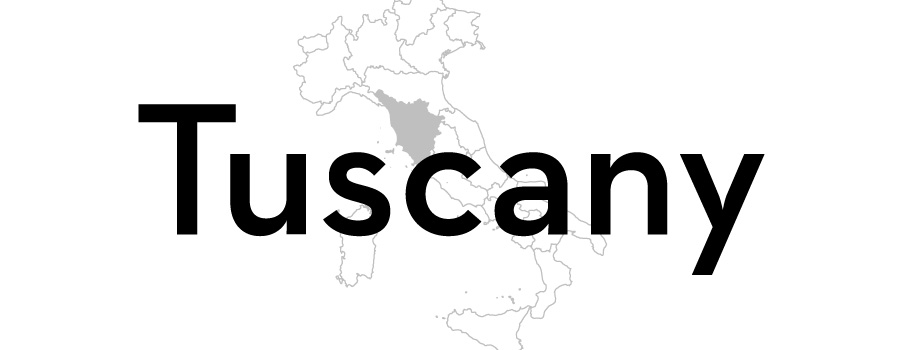
The wines of Tuscany
Marco Rossi introduces one of the most important winemaking regions of Italy and picks out some of the most interesting traditional and modern varieties around.
View more from this series:
Italian wineHave you ever wondered why the Mona Lisa has that charming smile on Leonardo da Vinci's famous painting? Well, the very moment you enter the gates of Tuscany you can't help smiling at the beauty of the region, and once you discover the pleasures connected to the local food and wines, that smile won't go away easily.
The word wine itself is immediately echoed by the name Tuscany. Ever since it became the focal point for the Renaissance, the area has earned a bit of a snobby reputation, partly thanks to its centuries-old traditions of winemaking. There are only a few other areas in the world that have as much wine-based history as Tuscany, which is something the locals are very proud of.
However, in the shade of these centuries-old vineyards lies a new wave of young innovators who have helped preserve Tuscany’s title as one of the best wine-producing regions in the world. This new generation are taking the native grape varieties of the area and reworking them, achieving top quality results. Some of the most important, traditional winemakers are based in Tuscany, but the growing number of organic, natural and biodynamic wines made in the region are becoming just as important.
If you want to see what all the fuss is about, it can be a little daunting to know where to start – so here are the DOCG, DOC and IGT varieties which best represent Tuscan wine.
DOCG wines
Sometime around 1800 AD, the Biondi Santi family decided a small hamlet called Montalcino would make the perfect spot to grow a particular clone of Sangiovese grapes called Brunello. They were absolutely right and since then Brunello has become one of the most important wines in the world thanks to low productions per hectare, a minimum of fifty months of aging in oak barrels (sixty-two months for the riserva) and the longevity of the wines that only start reaching maturity after fifteen years, making it appeal to wine collectors. The quality of the grape grown here is so high that the rules state no other grapes are allowed in this amazing wine.
- Visual: ruby red tending to garnet, quite consistent
- Bouquet: scents of undergrowth, of red fruit jam, spices, tobacco and leather
- Taste: the taste is dry, warm and soft with very strong and elegant tannins, very good flavor, remarkable freshness, as you'd expect from Sangiovese, an important structure completes the Brunello
- Pairing: Perfect with roasted or slow-cooked meats and aged cheeses
Must try:
Traditional: Biondi Santi – Tenuta Greppo Brunello di Montalcino Riserva DOCG (Sangiovese)
New wave: Sanlorenzo – Bramante Brunello di Montalcino Riserva DOCG (Sangiovese)
The clone of Sangiovese used to create this wine (often Mammolo and Canaiolo grapes are added as well as other varieties, which is allowed as long as seventy percent of the wine is Sangiovese) say a lot about the characteristics of Nobile (noble); it is called Prugnolo Gentile, which means gentle blackthorn. Sangiovese is a variety very difficult to grow outside of Tuscany, and in Montepulciano it is able to reach really high levels of quality and finesse. Small companies, low production per hectare, along with the aging in oak barrels allows this wine to evolve over the years in a really interesting way.
- Visual: ruby red with garnet shades when mature
- Bouquet: the nose gives off hints of ripe cherry, violet and spices
- Taste: dry, warm, quite tannic
- Pairing: perfect with pasta with game sauces, braised and grilled meats
Must try:
Traditional: Podere Sanguineto – Vino Nobile di Montepulciano Riserva DOCG (Prugnolo Gentile, Canaiolo Nero and Mammolo)
New wave: Podere Lamberto – Vino Nobile di Montepulciano DOCG (80% Blackthorn Gentile, 20% Canaiolo-Bashful-Colorino)
Chianti is among the oldest winemaking areas of Tuscany, and the name Classico is added for the tiny area within that represents the origins and starting point of this kind of wine. Among these beautiful landscapes you can find all sorts of traditional wine varieties, but we can't forget about all the young innovators whose small companies are taking the area to a new and modern level.
Sangiovese grapes should always make up at least eighty percent of Chianti Classico DOCG wines. Compared to the larger DOCG Chianti region, these wines are more apt to a long aging and have more structure, which is even more evident in the riserva.
- Visual: ruby red, not too intense
- Bouquet: good intensity with notes of mature red fruits, ripe berries, violets and spicy notes, with vanilla and often a hint of cinnamon
- Taste: dry, warm, soft, elegant tannins, very mineral and a freshness above average with a long finish
- Pairing: Bistecca alla Fiorentina (Florentine steak) – what else?
Must try:
Traditional: Castello di Monsanto – Cru Poggio Chianti Classico DOCG (Sangiovese)
New wave: Istine – Vigna Cavarchione DOG Chianti Classico (Sangiovese)
• Vines appeared in Tuscany since before the Etruscans (an ancient Italian civilisation that lived in Tuscany before the Romans), around the 700 BC
• Tuscany was already exporting wine to other Mediterranean countries during Etruscan times
• During the Middle Ages (800 AD) Tuscan wine became famous among the upper classes
• In Florence, the vineyards invaded the city center and the courts thanks to the ‘noble’ appeal of the plant and the status which came with owning a winery
• The first mention of Tuscan winemaking techniques was made in 1276
• In 1404 the word Chianti appeared in a book for the first time, where it was the most popular drink in the papal court
• In 1716 Cosimo III de 'Medici created the idea of DOC wines and gave birth to a simple classification that continues today
Not to be confused with the Chianti Classico which is located right in the centre of Chianti, this production area is very large and covers many provinces. Sangiovese is still the main variety and never goes below seventy percent in blends, in compliance with guidelines issued by Bettino Ricasoli during the nineteenth century.
Compared to Chianti Classico, Chianti wines are leaner and don’t need to be aged for quite as long. You will often hear experts referring to this wine as a ‘ready to drink’ bottle, the exception being the riserva which expresses very interesting evolutions during long ageing in the bottle.
- Visual: very intense ruby red
- Bouquet: cherry and violet aromas, mineral hints
- Taste: dry, soft and quite warm with an important freshness, delicate tannins and subtle saltiness
- Pairing: tripe, pork, cheese and again the Florentine Steak
Must try:
Traditiona: Vitereta – Casa Rossa Chianti DOCG (Sangiovese)
New wave: Podere Giocoli – Alione Chianti Riserva DOCG (Sangiovese)
DOC wines
Bolgheri is the homeland of the famous ‘Super Tuscans’, wines of great value from an international point of view. These wines are so popular that it led to the creation of a sub-area called Sassicaia, which covers the vineyards from which one of the most sought-after wines in the world is made.
Inside the Bolgheri area, thanks to the calm climate from the Tyrrhenian Sea, many grape varieties of French origin found a second home, such as Cabernet Sauvignon, Cabernet Franc and Merlot for the reds and Sauvignon for whites. The red wines are finished in French oak barrels as it wouldn’t make sense to refine a French variety in an Italian wood barrel. This respectful tradition has been followed for many years.
- Visual: deep red with purple reflections
- Bouquet: red fruit with small berries, pepper, tomato leaf, vanilla and spices from the barriques (French oak barrels)
- Taste: soft and warm with velvety and well-structured tannins and an evident Tuscan freshness that balances very well
- Pairing: hard, aged cheese, roasted and boiled meat
Must try:
Traditional: Tenuta San Guido – Sassicaia DOC (85% Cabernet Sauvignon, 15% Cabernet Franc)
New wave: Podere Sapaio – Sapaio Bolgheri DOC (70% Cabernet Sauvignon, 10% Cabernet Franc, 20% Petit Verdot)
This is quite a young DOC classification that was born only in 1999. There are all sorts of grape varieties used to make the wine, often French (for example Gamay, Pinot Noir, Merlot, Cabernet Sauvignon, Cabernet Franc, Syrah, Chardonnay and Sauvignon), but the thing that unites the wines of this territory is the finesse of the finished product. Cortona has become famous because Syrah grapes grow incredibly well in the area, probably second only to their homeland, the Rhone Valley.
- Visual: purple red with violet reflections
- Bouquet: good intensity with hints of underbrush and black pepper, dried red flowers
- Taste: soft and warm with evident silky tannins, good flavor and freshness, excellent finishing
- Pairing: game and aged cheeses-
Must try:
Traditional: Tenimenti D'Alessandro – Il Bosco Cortona DOC (Syrah)
New wave: Stefano Amerighi – Apice Cortona DOC (Syrah)
• Tuscany is a triangle of 22,994 square kilometres
• Nearly seventy percent of the region is hilly and twenty-five percent is mountainous, while less than ten percent is flat
• Along the coast Tuscany has a mild winter and a cool summer, while inland temperatures are subject to large fluctuations that allow the proper cultivation of Sangiovese red grapes with great results
• There are 60,000 hectares of vineyards in Tuscany
• Red wines represent nearly seventy percent of the regional production
• Sangiovese is the most common grape variety
IGT wines
The world of IGTs is growing in both quality and number. Many traditional important companies are now shying away from the strict guidelines of a DOCG or DOC disciplinary. This choice is because winemakers want to express the identity of the single vineyard rather than a traditional region. Producers like Fontodi, with its famous Flaccianello della Pieve IGT, are often named the best winemakers in the world, while Montevertine’s Pergole Torte IGT is one of the best Sangiovese wines you will ever taste.
However, it’s the innumerable small and young producers who choose to settle in unique territories without a history of winemaking that make IGT wines so exciting. These ‘new wavers’ (often organic, biodynamic and natural producers) prefer to express terroir through IGT wine. The Arezzo area, for example, is quite avant-garde, with young progressive micro companies like Ornina in the Casentino Valley in Tunia and Carlo Tanganelli in two different areas of the Val di Chiana and Podere di Pomaio.
Must try red wines:
Traditional: Montevertine - Pergole Torte IGT(Sangiovese)
New wave: Podere di Pomaio – Porsenna IGT (Sangiovese)
Must try white wines:
Traditional: Terra de 'Barberi - Chardonnay IGT (Chardonnay)
New wave: Carlo Tanganelli – Anatrino IGT (Trebbiano)
These wines are just a snapshot of the great selection available throughout Tuscany, but they’re the perfect ones to choose if you’re after the most characteristic varieties. The only thing you need to do now is uncork a bottle of this precious wine to start a new journey through the wonderful colors, aromas and smiles of this land.

